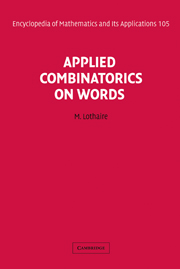Book contents
- Frontmatter
- Contents
- Preface
- Chapter 1 Algorithms on Words
- Chapter 2 Structures for Indexes
- Chapter 3 Symbolic Natural Language Processing
- Chapter 4 Statistical Natural Language Processing
- Chapter 5 Inference of Network Expressions
- Chapter 6 Statistics on Words with Applications to Biological Sequences
- Chapter 7 Analytic Approach to Pattern Matching
- Chapter 8 Periodic Structures in Words
- Chapter 9 Counting, Coding, and Sampling with Words
- Chapter 10 Words in Number Theory
- References
- General Index
Chapter 7 - Analytic Approach to Pattern Matching
Published online by Cambridge University Press: 05 June 2013
- Frontmatter
- Contents
- Preface
- Chapter 1 Algorithms on Words
- Chapter 2 Structures for Indexes
- Chapter 3 Symbolic Natural Language Processing
- Chapter 4 Statistical Natural Language Processing
- Chapter 5 Inference of Network Expressions
- Chapter 6 Statistics on Words with Applications to Biological Sequences
- Chapter 7 Analytic Approach to Pattern Matching
- Chapter 8 Periodic Structures in Words
- Chapter 9 Counting, Coding, and Sampling with Words
- Chapter 10 Words in Number Theory
- References
- General Index
Summary
Introduction
Repeated patterns and related phenomena in words are known to play a central role in many facets of computer science, telecommunications, coding, data compression, and molecular biology. One of the most fundamental questions arising in such studies is the frequency of pattern occurrences in another string known as the text. Applications of these results include gene finding in biology, code synchronization, user search in wireless communications, detecting signatures of an attacker in intrusion detection, and discovering repeated strings in the Lempel-Ziv schemes and other data compression algorithms.
In basic pattern matching one finds for a given (or random) pattern w or a set of patterns W and text X how many times W occurs in the text and how long it takes for W to occur in X for the first time. These two problems are not unrelated as we have already seen in Chapter 6. Throughout this chapter we allow patterns to overlap and we count overlapping occurrences separately. For example, w = abab occurs three times in the text = bababababb.
We consider pattern matching problems in a probabilistic framework in which the text is generated by a probabilistic source while the pattern is given. In Chapter 1 various probabilistic sources were discussed. Here we succinctly summarize assumptions adopted in this chapter. In addition, we introduce a new general source known as a dynamical source recently proposed by Vallée. In Chapter 2 algorithmic aspects of pattern matching and various efficient algorithms for finding patterns were discussed.
- Type
- Chapter
- Information
- Applied Combinatorics on Words , pp. 353 - 429Publisher: Cambridge University PressPrint publication year: 2005
- 1
- Cited by

